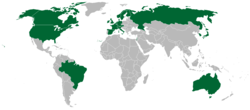Paris Club
|
Club de Paris
Paris Club |
|
|---|---|

Emblem
|
|
 |
|
| Secretariat | Paris, France |
| Languages | Engish, French |
| Membership | Australia, Austria, Belgium, Brazil, Canada, Denmark, Finland, France, Germany, Ireland, Israel, Italy, Japan, the Netherlands, Norway, the Russian Federation, South Korea, Spain, Sweden, Switzerland, the United Kingdom and the United States of America |
| Leaders | |
|
• Chairperson
|
Odile Renaud Basso |
|
• Co-Chairperson
|
Guillaume Chabert |
|
• Vice-Chairperson
|
Cyril Rousseau |
|
• Secretary General of the Paris Club
|
Geoffroy Cailloux |
| Establishment | 1956 |
The Paris Club (French: Club de Paris) is a group of officials from major creditor countries whose role is to find coordinated and sustainable solutions to the payment difficulties experienced by debtor countries. As debtor countries undertake reforms to stabilize and restore their macroeconomic and financial situation, Paris Club creditors provide an appropriate debt treatment. Paris Club creditors provide debt treatments to debtor countries in the form of rescheduling, which is debt relief by postponement or, in the case of concessional rescheduling, reduction in debt service obligations during a defined period (flow treatment) or as of a set date (stock treatment).
The Paris Club was created gradually from 1956, when the first negotiation between Argentina and its public creditors took place in Paris. The Paris Club treats public claims, that is to say, those due by governments of debtor countries and by the private sector, guaranteed by the public sector to Paris Club members. A similar process occurs for public debt held by private creditors in the London Club, which was organized in 1970 on the model of the Paris Club is an informal group of commercial banks meet to renegotiate the debt they hold on sovereign debtors.
Creditor countries meet ten times a year in Paris for Tour d'Horizon and negotiating sessions. To facilitate Paris Club operations, the French Treasury provides a small secretariat, and a senior official of the French Treasury is appointed chairman.
Since 1956, the Paris Club has signed 433 agreements with 90 different countries covering over US$583 billion.
Since 1956, the Paris Club has remained a central player in the resolution of developing and emerging countries' debt problems.
In 1956, the world economy was emerging from the aftermath of the Second World War. The Bretton Woods institutions were in the early stages of their existence, international capital flows were scarce, and exchange rates were fixed. Few African countries were independent and the world was divided along Cold War lines. Yet there was a strong spirit of international cooperation in the Western world and, when Argentina voiced the need to meet its sovereign creditors to prevent a default, France offered to host an exceptional three-day meeting in Paris that took place from 14 to 16 May 1956.
Today, the Paris Club provides debt treatments to debtor countries in a totally different world. Most countries are active players in the world economy and are interdependent through goods and capital flows. Financial globalization has created new opportunities for developing and emerging countries but has brought with it new risks of crisis. Sovereign debt is a minor source of borrowing for emerging economies given the development of emerging bond markets. But the low-income countries generally do not have access to these markets and assistance from bilateral and multilateral donors remains vital for them. Non-Paris Club creditors are becoming an increasingly important source of financing for these countries. Yet despite the fact that Paris Club creditors now have to deal with far more complex and diverse debt situations than in 1956, their original principles still stand.
...
Wikipedia
